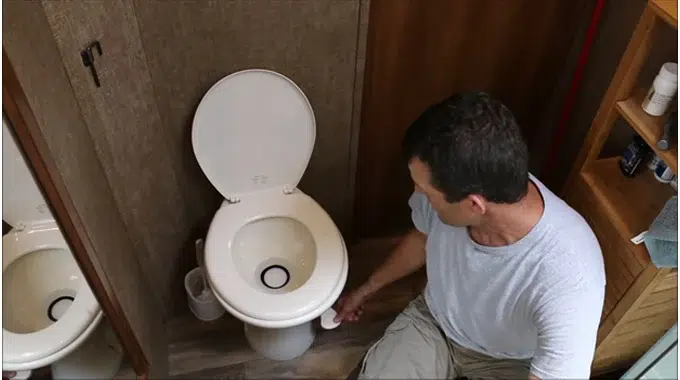Last Updated on April 20, 2023
An RV toilet that is wobbly can be a very annoying and potentially dangerous problem. If left unchecked, it can lead to structural damage, water leaks and even cause you to lose balance while using the toilet. It could be caused by several factors, but the most common cause is not tightening the bolt correctly or the flange on the RV toilet being damaged or corroded.
Therefore, fixing a wobbly RV toilet should be a priority for RV owners who want to stay safe and comfortable on the road. A simple fix for this problem is tightening the toilet base bolts. But what if you’ve done that, and it still wobbles?
Below, we’ll discuss why my RV toilet is wobbly and how to fix it. So read on to find out how to keep your toilet secure and stable.
Why Is My RV Toilet Wobbly? Investigate the Causes and Solutions
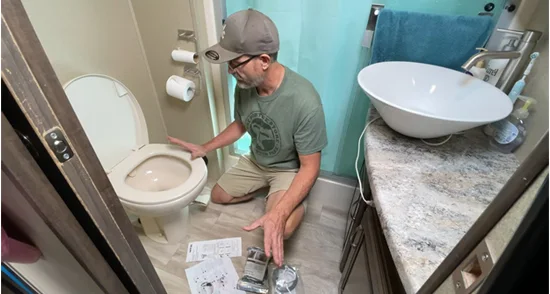
From loose bolts to worn-out rubber seals, there are many reasons why your RV toilet isn’t staying seated. The good news is that this problem can usually be fixed with a few simple repairs. Below, we’ll discuss the most common causes of a wobbly toilet and how to fix them:
Loose Bolts:
If you notice that the RV toilet is wobbly and it seems to be caused by loose bolts, then it’s likely some missing or broken bolts were holding the toilet in place. To fix this, you will need to get new bolts from a hardware store and use a wrench to tighten them up again.
You may also need to replace any broken washers, nuts, or other pieces that may have come loose. Once the bolts are secure, you’ll want to check the supporting base and make sure all of the screws are also tight so that nothing else becomes loose. Using Brass Plated Bolts, RV toilet seal kits, Brass Closet Bolts with Nuts and Washers is a recommended option.
Broken RV Toilet Flange:
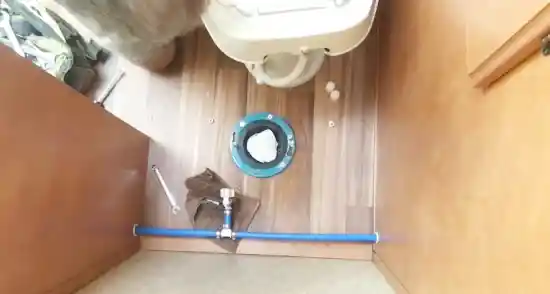
A broken flange can also cause your RV toilet to wobble. This is because the flange is what holds the toilet bowl in place and provides a seal against water leakage. If it breaks, then there won’t be anything supporting the bowl or keeping it from moving around when someone sits on it.
To fix this problem, you’ll need to replace the toilet flange with a new one of the same size and shape as your old one. Make sure to use the plumber’s putty around the edges for adequate sealing against RV toilet leaking. Don’t overtighten the flange bolt, as it can break.
Some good rv toilet flanges are rv toilet flange for dometic/sealand gravity, male threaded floor flange, ultra fit metal closet flange, etc.
Damaged Wax Ring:
The wax ring helps create a tight seal between the bottom of your toilet bowl and whatever material (such as wood) rests underneath it, providing additional support for stability when someone uses it. If you notice that the wax ring on your RV toilet is damaged or missing completely, then it might be causing your toilet to wobble upon sitting due to insufficient support from below.
As a solution, you’ll need to remove any existing wax ring first before replacing it with a new wax seal of identical size and shape, making sure all edges are sealed properly with the plumber’s putty beforehand for better results.
Weak Floor:
Weak floors are another common cause of a wobbly RV toilet because if there is insufficient support beneath its base, then it will not be able to stay level when someone sits down on it or when weight is added during use. If left unchecked for too long, this lack of sturdiness will eventually cause an unstable foundation for your RV’s plumbing system.
To prevent weak floors from causing problems with your RV’s plumbing system, make sure you reinforce weak spots by adding extra joists around potential problem areas or by adding additional supports underneath vulnerable areas before re-installing any fixtures, such as toilets within them again.
Broken Toilet Base:
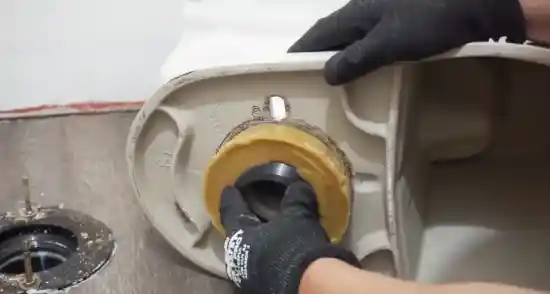
Broken bases are another common source of wobbly toilet connections within an RV’s plumbing system because when they get cracked or otherwise damaged, they won’t provide enough support for toilets anymore, leading them to become shaky when someone uses them on top of them.
To resolve this issue, it might be necessary for you to replace any broken bases with new ones as quickly as possible to keep everything stable. However, if you’re unable to find a suitable replacement, then you might have to consider replacing the entire toilet bowl and base with a new one instead.
Seals Wearing Down:
The seals of an RV toilet can become worn down with age, use, and exposure to the elements. This can cause them to become loose and wobbly, leading to a less secure seating experience. The seals can be made from rubber or foam, depending on the model, but both are vulnerable to wear over time.
To avoid this issue, it’s essential to inspect the seals regularly for signs of thinning or cracking and replace them when necessary. Ensure that any sealant around the toilet’s base is in good condition.
Faulty Mounting Brackets or Screws:
If the mounting brackets or screws that hold your RV toilet in place are faulty or missing, then your toilet will be prone to wobbling. Check that all screws are properly tightened at regular intervals and that none have become damaged due to corrosion or other wear-and-tear issues.
Corrosion on Any Metal Parts
Metal parts on an RV toilet, such as hinges and brackets, can corrode over time due to humidity caused by steam from showers and baths as well as salt air if you live near a coastline or lakefront property.
To prevent wobbling and potential future problems with a loose seat, regularly inspect for signs of oxidation, such as rust spots or discoloration. Replace any rusty parts without delay.
Overloading the Toilet Seat
The average weight capacity of a toilet seat is approximately 350 lbs, but some may be rated for more or less depending on the design, size, and materials used. It can become wobbly over time if a person overloads the toilet seat with items like books, tools, or pets. Being overweight causes extra strain on the toilet frame, causing weakened parts and instability.
To avoid this problem from occurring, it’s best to always check the manufacturer’s recommended weight limit before using any type of RV toilet seat and make sure not to overload it with additional items.
RV Toilet Maintenance: What Should You Do?
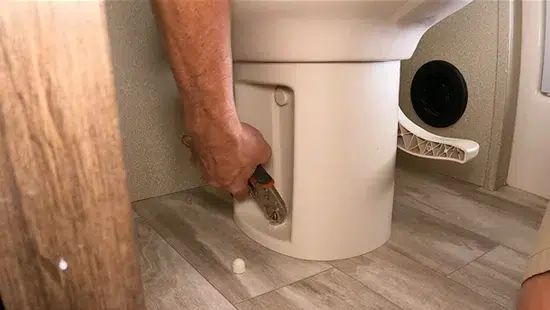
RV Toilet Maintenance is an important step to ensure the long-term functionality of your recreational vehicle. Proper maintenance for toilets involves:
Regularly Checking All Components
When going through your RV toilet maintenance routine, it’s important to check all components of the toilet thoroughly. This includes examining hinges, seals, bolts, and other parts for any signs of damage or wear.
Ensuring No Excessive Weight
Before and after each use, it’s essential to ensure no excess weight is placed on top of the device that could damage it over time. Be aware of how many extra supplies you have stored in the RV’s bathroom area that could weigh it down and strain the plumbing fixtures over time if not monitored closely.
Sealing Any Connections That Need It
If you notice any loose connections in your RV’s toilet plumbing system or wobbly toilet fittings around drains or seals, then you need to address these problems immediately by resealing them properly.
Adding Extra Support To The Toilet’s Back
Another important step in maintaining your RV’s toilet is to add extra support to the back of the toilet. This can be done by using a sturdy board or piece of plywood, which will help keep it steady and stop wobbling.
Secure All Bolts, Nuts, Washers, and Other Hardware
To ensure that your RV toilet remains secure and functions properly, it is important to check all of the nuts, bolts, and washers to make sure they are tightly secured.
Replacing Damaged Parts With New RV-Certified Components
If any of the components in your RV toilet become damaged or worn down through regular use or aging, they should be replaced with new ones certified for use in RVs.
Tightening All Fasteners and Connections
Loose connections can cause a variety of problems with your RV toilet, from toilet leaks or blockages in the pipes leading away from it to mechanical failures due to poor connection between parts. Carefully inspect all fasteners and connections regularly and re-tighten them if needed.
Try Not to Over-Tighten Any Bolt or Screw
If a bolt or screw is too tight, it can cause warping or damage, so be careful not to over tighten them when doing routine maintenance on your RV toilet. A good practice when tightening screws is slowly increasing the pressure until you feel completely secure about the connection.
By following these steps, you can help keep your RV toilet in good working order and avoid any wobbly issues.
Is It Worth It to Caulk the RV Toilet’s Base?
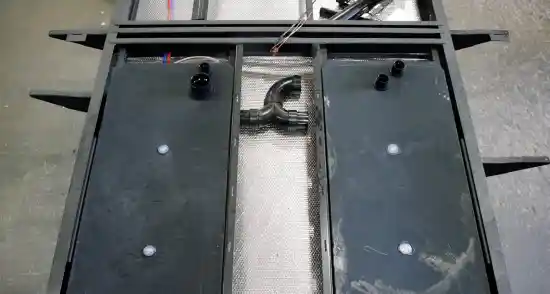
When it comes to maintaining an RV, many people debate whether or not it is worth it to caulk the base of the toilet. After all, caulking can be a time-consuming process and may not always be necessary. The truth is that while there are some cases in which caulking may provide greater protection, in most cases, it is likely not necessary or even recommended to caulk around the base of the RV toilet.
Due to its constant movement, caulking the RV toilet’s base is generally not recommended. When an RV moves along a road or highway, the entire chassis shifts and vibrates. This motion results in cracks forming in any caulk that has been applied, effectively rendering its protective properties moot.
One other thing to keep in mind when deciding whether or not to caulk around the RV toilet’s base is that toilets are usually made out of durable materials like porcelain or other synthetic materials. As such, these materials should be able to withstand normal wear and tear without needing additional protection from the caulk.
But if you find that caulk is necessary for your RV toilet’s base, make sure to use a sealant that has been approved for use in RVs, and that is specifically designed to adhere to the materials used in your RV’s black tank. As a precaution, be sure to inspect the caulk regularly and re-seal areas as needed.
Is It Necessary to Maintain RV Toilets Regularly?
It is indeed essential to regularly maintain RV toilets. The various parts and components of the recreational vehicle’s toilet system need to be inspected and adjusted regularly to ensure that it continues to work properly. Without proper maintenance, the RV rocking toilet can become clogged or damaged, leading to costly repairs or even the replacement of parts.
For this reason, it’s important to inspect and repair any issues whenever they appear to keep RV toilets working without being wobbly. Regular maintenance prevents damage and helps maintain your toilet’s durability.
So now that you know everything there is to know about RV toilet maintenance and repair, there’s no excuse not to keep yours working in top condition. A little bit of regular RV maintenance can go a long way in keeping your RV toilet running smoothly and securely.

